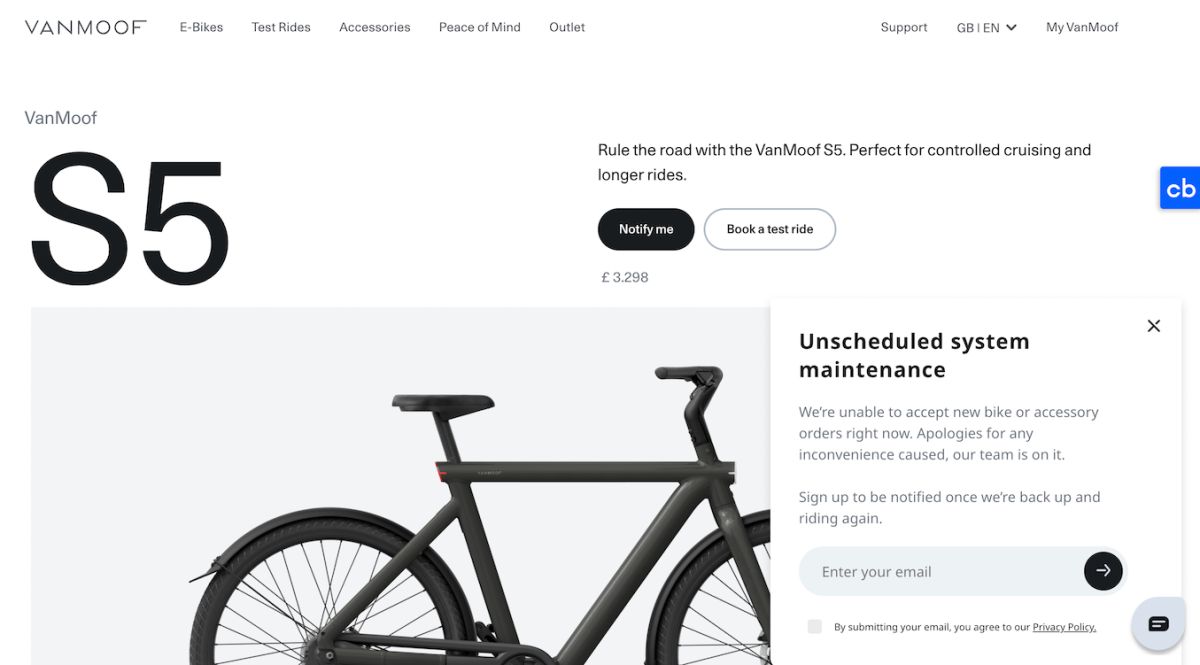VanMoof, the e-bike darling, skids off track: Sales paused, execs depart
Dutch e-bike startup VanMoof sped into the mobility world with more than $200 million from a list of big-name investors and an ambitious, trendy spin on two-wheeled electric travel: sleek e-bikes designed end-to-end. The battery was beautifully hidden from view, the bike was controlled by an integrated app and the whole package was priced at a premium. Well-heeled and aspirational consumers who liked the idea of sustainable, healthier urban travel lapped it up.
But now VanMoof’s strategy and momentum appear to have steered dangerously off course, say multiple sources spoken to by TechCrunch. Our sources tell us that VanMoof is working on securing a bridge round that will help it stay afloat. Sources also claim that senior staff, including the CEO and a co-founder, as well as the president (who is also an investor) have left executive roles in the business. The company has refused to provide any on-the-record comment on its status until later this week.
But the facts are plain: The company has, as of June 29 and by its own admission, stopped taking orders. VanMoof also filed paperwork, revealed in January, of its need to raise money to stave off bankruptcy.
Customers, annoyed with the pauses and other delays in servicing existing bikes on the road, have turned to social media like Reddit and Twitter to air their complaints and debate whether the company is going bust or not.
Sources say that a decision on the fate of VanMoof could come as soon as this week. VanMoof did provide comment on some aspects of this story, but official representatives and the startup’s investors ultimately declined to answer multiple other questions about what is coming next.
Paused sales? ‘A feature, not a bug,’ says company
The first recent, visible cracks in the company appeared in late June when potential customers discovered its online ordering system was no longer working.
“Unscheduled system maintenance: We’re unable to accept new bike or accessory orders right now. Apologies for any inconvenience caused, our team is on it. Sign up to be notified once we’re back up and riding again.”
Soon after, the company’s Twitter account elaborated to say it was a technical glitch causing the issue: “VanMoof app currently has a bug which is not making it possible to book an appointment through the app,” the tweet read.
Our VanMoof app currently has a bug which is not making it possible to book an appointment through the app. You can still book an appointment via your MyVanMoof account🤖 Our teams are working on getting the app back up and running as soon as possible. — VanMoof (@VanMoof) June 26, 2023
The story changed again a few days later.
In response to TechCrunch’s questions about the ordering system, a spokesperson said that the pause was actually intentional (a feature not a bug!).
Despite the summer period being the peak season for the cycling market, a VanMoof spokesperson claimed it would be pausing orders to catch up on production and delivery.
“We have paused sales since this weekend,” she said. “What started as a minor IT issue had an unexpected upside. Both the SX4 and the SA5 [two newer models it launched this year] have proven to be very popular product lines — and proactively pausing sales will give us an opportunity to catch up on delivery and production of existing orders.”
The company didn’t answer any of TechCrunch’s multiple questions about why VanMoof was behind on orders (supply chain issues? lacking funds?), what the company’s current capacity was, how many orders were outstanding, or when VanMoof hoped to begin sales again. As of the time of publication, the sales pause was going on 12 days.
Warning signs
Despite the pause and the other details, VanMoof had been sending out communications that imply it’s business-as-usual at the e-bike company. On June 27 it announced that KwikFit NL, the car maintenance chain, would be a new service partner. The day before that it issued a firmware update and a video was posted of a panel that co-founder Taco Carlier participated in.
But there have been a number of warning signs in plain sight for months that tell a different story.
In January, it emerged that the company had been in talks with investors to raise between €10 million and €40 million ($10.8 million-$43.3 million). On top of that, its most recent set of accounts led it to project that it would struggle to remain liquid in the first quarter of the year without the cash injection.
VanMoof did manage to raise a little, but nowhere near the amount it was looking for. PitchBook notes that its last funding was in January 2023, a $5.23 million debt round from TriplePoint Capital in the U.S.
We’ve since heard from sources that in fact VanMoof is trying to raise more, given that gap between what it has and what it needs to operate.
Glassdoor estimates that the company has between 500 and 1,000 employees, and from what we can see it hasn’t had any notable rounds of layoffs to date — one cost-cutting measure that many companies in this down-market have resorted to. But there have been some notable executive exits.
Gillian Tans, the former head of Booking.com who has also invested in VanMoof, joined as the company’s president on May 3, 2022, according to the company’s web site.
A well-placed source familiar with the matter told TechCrunch that Tans quietly left the company — we’re not sure when exactly. Notably, her LinkedIn profile has no mention of VanMoof at all.
We’ve also heard that Taco Carlier, who co-founded the company with his brother Ties, is no longer acting as CEO. VanMoof would not comment on this detail to us, either, but he doesn’t list CEO as his title on LinkedIn, and in a recent stage appearance he was also only described as a co-founder. It appears there is no one acting publicly as CEO. VanMoof would not comment on this, either, although they did offer us an interview with Carlier (offered also just as a co-founder), but only if we agreed to hold off on publication.
A competitive market for e-bikes
For those who have watched startup after startup raise large rounds of funding for capital-intensive efforts that have produced promising early results, or just sound great on paper, the story will sound familiar.
VanMoof started 14 years ago with a “mission,” in the words of Taco Carlier, “to get just as many people on bikes on the streets of New York, Paris, London, Tokyo as we have in our hometown of Amsterdam.” It has raised, per PitchBook data, just over $225 million from investors that include Balderton, Norwest Venture Partners, Felix Capital and China’s Hillhouse Capital Management. The company has never disclosed its valuation.
The bulk of that came in a $128 million round in September 2021 — part of the wave of big funding rounds investors directed toward companies that felt timely in light of the COVID-19 pandemic.
For tech investors, VanMoof represented the European startup leader in the huge push toward more efficient transportation around cities, greener alternatives to cars and, after the emergence of the COVID-19 pandemic in 2020, ways to avoid crowding up with strangers on public transport — a movement that municipalities also supported with better road networks and bike lanes. VanMoof was positioned as the stylish, high-end brand that packaged all the complexity of a bike, and the maintenance of a bike, into one elegant package (not unlike Apple’s consumer electronics approach), with a price tag to match.
As one cyclist described it, “It’s an expensive bike for people with money who might not actually know a lot about bikes.”
VanMoof, with its integrated design with smart touches like bike tracking and app assistant, and e-commerce interface, was every bit the startup, and it touted itself as “the most-funded e-bike company in the world.” But it wasn’t the only e-bike player. Other startups also built around distinctive designs such as Rad Power Bikes (last valued at $1.65 billion, per PitchBook, in October 2021) and Cowboy (also a healthy funding recipient, but itself facing its own issues at the moment). Some began building accessories to give an electrifying boost to regular bikes (such as Swytch). And then all the established bike brands (Trek, Specialized and Giant, for example) began electrifying models.
VanMoof’s approach has been highly verticalized to date: It has designed the bike itself as well as the integrated app that controls it. It also has eschewed using off-the-shelf components in the building of the bike — a very common aspect of how bikes are made and fixed generally — opting instead to work with suppliers to manufacture custom components.
That itself has proven to be an extremely challenging approach. Dutch financial publication FD noted, in January, that the accounts showed VanMoof was actually losing money on each of its expensive bikes, due to the cost of repair. Owners couldn’t repair bikes themselves, and so needed to send them into VanMoof repair centers to be fixed. Those that were under warranty would cost the company money to service, to the tune of €8 million ($8.92 million) in 2021.
Its bikes come with one-year warranties, and so some new owners were unhappy enough to return them altogether in that time period. FD reported that one in 10 were being sent back.
Objectively, even if VanMoof manages to get over its current issues, it will have missed the all-important summer cycle sales season. While the company is keeping tight-lipped for now, the market will be looking for a strong statement of some kind about its plans, and its funding, but the headwinds on this ride may well prove to be too strong to continue.
Source: TechCrunch


